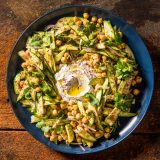Unassuming. It’s the most accurate way to describe the billing this dish got. On an unadorned menu printed on the sort of rough paper children once used to cover schoolbooks, the hints of what was to come in fact were just a handful of equally unadorned words. Kussa (the Arabic for zucchini), courgettes (the British for the same), za’atar vinaigrette and chickpeas.
Not a lot to go on, which is why I nearly skipped over it during my meal at Coal Office, an upscale yet relaxed London outpost of modern Middle Eastern cooking where techno beats pulse and the food is bold, brash and bright. And that would have been a shame. Because during a weeklong exploration of the city’s Middle Eastern food scene, it was a standout.
Actually, despite the simple sales pitch, everything on the menu was terrific. Credit for that goes to Assaf Granit, a chef originally from Jerusalem who is a wizard at balancing contrasting tastes and textures. His “Freekeh & Cabbage” I ate that same night—described equally sparingly—was a riot of chewy wheat spiked with chili, almonds, lemon and skordalia.
Likewise, his “Fennel Bun,” which pretty much amounted to a lusciously tender pretzel roll studded with crunchy savory-sweet seeds inside and out with a dollop of tahini, olive oil and tangy sumac for dunking. I could have stopped right there.
But that kussa! The waiter helpfully explained that it was a zucchini salad, but like the menu, even that description doesn’t quite do the dish justice. What arrived was a tangle of tender produce punctuated by meaty chickpeas, dill, mint and cilantro, all of it drizzled with creamy tahini, sumac, briny chopped dried black olives, and thick labneh blended with a za’atar dressing.
The flavors and textures floored me. Too often, zucchini’s bland and watery side dominates when it is served raw. Not here, where so many flavors at play made it the perfect vehicle. For our version, we did simplify a bit, but used a few tricks to ensure we sacrificed none of the flavor.
Foremost, we use a brief stint in the microwave to amplify the flavors. A mix of chickpeas, thinly sliced shallot, za’atar and red wine vinegar are warmed for just a couple minutes, then allowed to cool. This not only tenderizes and mellows the shallot, but as the chickpeas cool, they better absorb the flavors of the vinegar and za’atar than if dressed cold.
Our dressing is a creamy-savory blend of yogurt, tahini, lemon zest and juice, and a bit of olive oil. We liked the presentation—as well as the satisfaction of dunking—of mounding the dressing in the center of the dish and heaping the mixture of zucchini, chickpeas and herbs around it. Topped with a bit more oil and a sprinkle of sumac, the results—once again—defy simple descriptions.
The Middle East Reinvents the Summer Salad
Meaty chickpeas and a creamy za’atar-spiked dressing transform zucchini.
Photo: Connie Miller of CB Creatives; Styling: Christine Tobin







